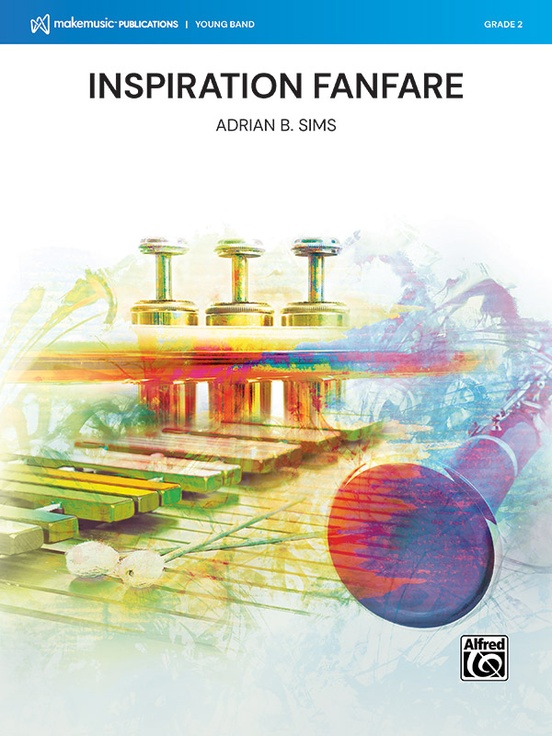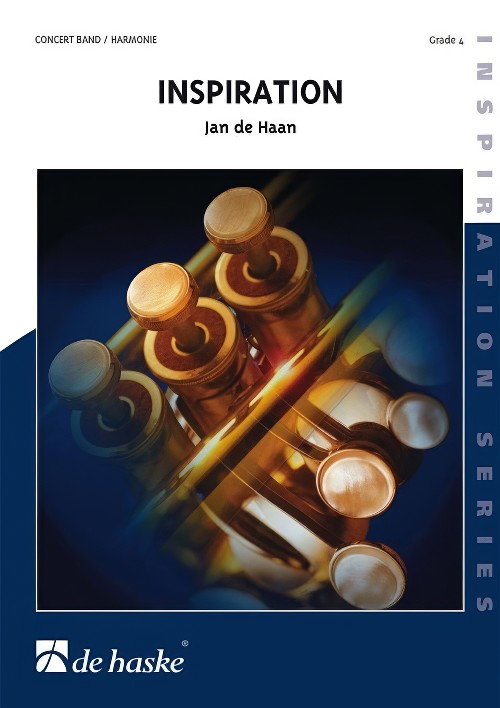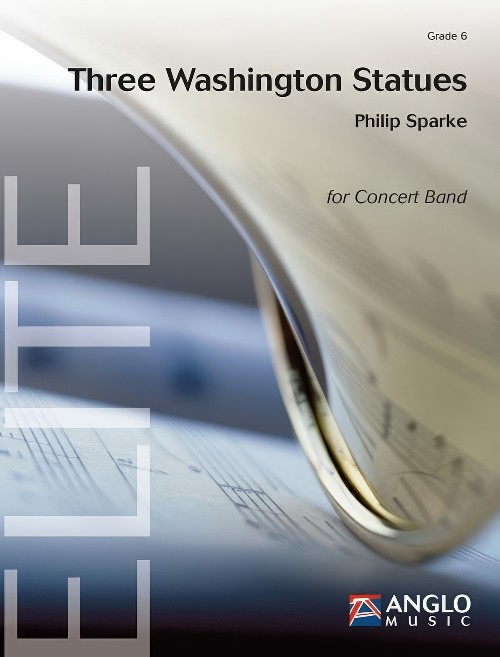Results
-
 £66.95
£66.95Inspiration Fanfare - Adrian B. Sims
Fueled by the inspiration of morning sunlight, Adrian Sims has written this colorful fanfare depicting joy and opportunity. The opening statement transforms throughout the piece, providing musically engaging parts for all. Extremely playable yet sophisticated in sound, Inspiration Fanfare creates a sense of anticipation and excitement. A joyful celebration of music!
Estimated delivery 7-14 working days
-
 £66.95
£66.95Inspiration Fanfare (Concert Band - Score and Parts) - Sims, Adrian B.
Fuelled by the inspiration of morning sunlight, Adrian Sims has written this colourful fanfare depicting joy and opportunity. The opening statement transforms throughout the piece, providing musically engaging parts for all. Extremely playable yet sophisticated in sound, Inspiration Fanfare creates a sense of anticipation and excitement. A joyful celebration of music!Duration: 2.15
Estimated delivery 7-14 working days
-
 £139.99
£139.99Inspiration - Jan de Haan
Inspiration was commissioned by the Solothurnischer Kanotonal Musikverband in Switzerland in 1993. The composition begins with an A-theme written in a Phrygian tonality and, after an enormous climax, moves on into a quicker B-section, characterized by the use of wide interval jumps. Then follows the development in which both themes return individually and together. Peace and quiet is restored in the slow middle movement, based on the B-theme. The movement comes to a close with a tutti B-theme, brutally interrupted by fragments from the A-theme. Without a break, the final movement of this contrastive piece develops from these fragments. The theme of this extremelyrhythmical closing movement is built up of elements from the A-theme, whilst the B-theme (from the slow middle movement) returns in full once more. Before the piece comes to a close in a resounding fortissimo, the cornet soloist performs the A-theme from the back of the auditorium, to special effect.
Estimated delivery 7-14 working days
-
 £139.99
£139.99Inspiration (Concert Band - Score and Parts) - De Haan, Jan
Inspiration was commissioned by the Solothurnischer Kanotonal Musikverband in Switzerland in 1993. The composition begins with an A-theme written in a Phrygian tonality and, after an enormous climax, moves on into a quicker B-section, characterized by the use of wide interval jumps. Then follows the development in which both themes return individually and together. Peace and quiet is restored in the slow middle movement, based on the B-theme. The movement comes to a close with a tutti B-theme, brutally interrupted by fragments from the A-theme. Without a break, the final movement of this contrastive piece develops from these fragments. The theme of this extremely rhythmical closing movement is built up of elements from the A-theme, whilst the B-theme (from the slow middle movement) returns in full once more. Before the piece comes to a close in a resounding fortissimo, the cornet soloist performs the A-theme from the back of the auditorium, to special effect.Duration: 10:00
Estimated delivery 7-14 working days
-
£109.99
Inspiration Point - James Barnes
Estimated delivery 7-14 working days
-
 £344.30
£344.30Goldberg 2012 - Svein H. Giske
The first time I heard Bach's Goldberg Variations was in the movie Silence of the lambs, in the early 1990s. I noticed the beautiful background music in one of the scenes, but at that time I didn't know what it was. A few years later, when I was studiying at the Grieg Academy, I got to know the entire piece. For me, this is a piece of music which I can listen to countless times. I think it sounds as fresh today as it did more than 15 years ago and it never ceases to inspire me. Both Bach's composition and Glenn Gould's famous 1955 recording (which was the first one I heard) still makes a great impression on me. Before Gould recorded it at age 22, it wasn't a highly ranked piece amongst pianists and Bach was by many viewed as a bit old-fashioned. The young Canadian turned all this around. He managed to portray Bach in a reformed way, producing fine nuances in phrasing and making the many layers in Bach's music more transparent than anyone before him. Thus he plunged both himself and Bach (back) onto the international music scene. When The Norwegian Band Federation (NMF) asked me to write the test piece for NM in 2012, it was only natural for me to use the Goldberg Variations as a starting point and inspiration for my work. Since I was a teenager at NMF's summer courses in the mid eighties I've always listened to many different styles of music. Growing up in Sunnmre with the Brazz Brothers as teachers and mentors, jazz-, pop/rock- and folk music were early on a natural part of my musical background. I also have my classical education from the Grieg Academy on trumpet. As the title of my piece implies, I've wanted to bring Bach to the present and put his music into various modern musical landscapes. I think you can bring about a special kind of energy when music from different genres are mixed and I've tried to do this by mixing Bach with artists and musical styles from the present. In Goldberg 2012, the music is often constructed by several layers, which in a way are living parallel musical lives. They are seemingly moving or floating freely, almost unaware of each other, but bound together by the same basic pulse. The rythms, however, are often notated on a different rythmic subdivision level than the usual 8th- or 16th note levels. By doing this, I hope to achieve transparent sounds that rythmically are perceived as more free and detached from each other. In large sections of the piece, pop/jazz is fusioned with elements from Bach. I guess you could have this little scene as a synopsis for the piece: picture a group of musicians meeting: some are classical performers, some are jazz. They start to improvise together, each in their own voice or musical dialect and I'm sort of in the middle, trying to write down what they are playing. This is what I feel much of Goldberg 2012 is about. The foundation of the piece, in addition to Bach and references from pop/jazz music, lies also in my own material. This material, basically two chords, is heard in it's purest form in the 1st movement. I use these chords to create scales, new chords and different motifs which contribute to blend together the different moods of the piece. It has not been my intention to copy Bach's form (theme and 30 variations), but rather to use the bits and pieces that I like the most as an inspiration for my own variations. The 1st movement, Aria 2, is for my 3rd son, Olav, who was born on the 21st of April 2011, and the 5th movement, From long ago, is dedicated to the memory of my father, Svein J. Giske, who passed away on the 6th of June 2011. -Svein H. Giske, January 2012-
Estimated delivery 7-14 working days
-
£139.99
Cobra - Jan Bosveld
Shortly after the Second World War, a combative movement of Danish, Belgian and Dutch artists chose the cobra snake - extremely dangerous yet considered sacred - as a symbol of their resistance to strict guideliness of form. The name "Cobra" also happens to contain the first letters of the cities Copenhagen, Brussels ans Amsterdam, from where most of the movement's members came. The Cobra movement, which existed from November 1948 until November 1951, can with some justicication be called the last major avant-garde movement of the 20th century.The source of inspiration for the composition Cobra comes from four paintings: "Obhobning" by the Dane Egill Jacobsen; "La jeune fille et lamort" by the Belgian Pierre Alechinsky; "Orgeldraaier" and "Le rythme joyeux de la ville" by the Dutch artists Karel Appel and Corneille. Obhobning means "pile-up", which is represented musically in the first part by a melodic and harmonic pilling up of perfect fourth's. The first part is also characterized by a rhythmic feeling, which the painting gives through its use of numerous black stripes. In the painting La jeune fille et la mort, Pierre Alechinsky places a young girl opposite Death. The second part features the constantly pulsating motion of live while a creeping, dark, melodic line develops. The tension between life and death is tangible as a battle reveals itself. In part three, one hears the Orgeldraaier by Karel Appel, as cheerful and playful as an organ grinder's music. The painting Le rythme joyeux de la ville by Corneille is busy and extremely dynamic, a perfect source of inspiration for a powerful, rhythmic ending to this composition.
Estimated delivery 7-14 working days
-
 £72.95
£72.95Boundless Hope - Mark Lortz
Starting with a mallet percussion ostinato, this contemporary ballad for developing bands would also work well as a reflective selection for more advanced ensembles or as a contrasting selection in concert or contest. Written to represent thoughts, feelings and emotions during one's life, the composition is based on the Lydian mode, which naturally gives a sense of positivity, hopefulness, inspiration, and heavenly colors. Use this to introduce the study of modes, develop lyrical playing skills and as inspiration for all performers and listeners.
Estimated delivery 7-14 working days
-
 £164.99
£164.99Three Washington Statues (Concert Band - Score and Parts) - Sparke, Philip
Three Washington Statues was commissioned by the United States Army Band "Pershing's Own", led by Colonel Thomas H. Palmatier. Washington D.C. contains some of the world's most iconic monuments, memorials and statues. Philip Sparke has chosen three of these as the inspiration for this piece: 'The Lincoln Memorial' in the form of a Greek Doric temple in which the composer depicts the grandeur of this monument; 'The Martin Luther King, Jr. Memorial' on which steps the iconic speech 'I have a dream' was given - the music is both reverential as well as powerful referring to Martin Luther Kings' speech; and the 'Encore' statue in memory of the world famous African-American composer, pianist and bandleader Duke Ellington. In this final movement, Philip Sparke catches the virtuosic, energetic and unique dynamism of Ellington's' music. Three Washington Statues was commissioned by the United States Army Band "Pershing's Own", led by Colonel Thomas H. Palmatier. Washington D.C. contains some of the world's most iconic monuments, memorials and statues. Philip Sparke has chosen three of these as the inspiration for this piece: 'The Lincoln Memorial' in the form of a Greek Doric temple in which the composer depicts the grandeur of this monument; 'The Martin Luther King, Jr. Memorial' on which steps the iconic speech 'I have a dream' was given - the music is both reverential as well as powerful referring to Martin Luther Kings' speech; and the 'Encore' statue in memory of the world famous African-American composer, pianist and bandleader Duke Ellington. In this final movement, Philip Sparke catches the virtuosic, energetic and unique dynamism of Ellington's' music.Duration: 8:45
Estimated delivery 7-14 working days
-
 £139.99
£139.99Cobra Wind Band Set (Score & Parts)
Shortly after the Second World War, a combative movement of Danish, Belgian and Dutch artists chose the cobra snake - extremely dangerous yet considered sacred - as a symbol of their resistance to strict guideliness of form. The name "Cobra" also happens to contain the first letters of the cities Copenhagen, Brussels ans Amsterdam, from where most of the movement's members came. The Cobra movement, which existed from November 1948 until November 1951, can with some justicication be called the last major avant-garde movement of the 20th century.The source of inspiration for the composition Cobra comes from four paintings: "Obhobning" by the Dane Egill Jacobsen; "La jeune fille et la mort" by the Belgian Pierre Alechinsky; "Orgeldraaier" and "Le rythme joyeux de la ville" by the Dutch artists Karel Appel and Corneille. Obhobning means "pile-up", which is represented musically in the first part by a melodic and harmonic pilling up of perfect fourth's. The first part is also characterized by a rhythmic feeling, which the painting gives through its use of numerous black stripes. In the painting La jeune fille et la mort, Pierre Alechinsky places a young girl opposite Death. The second part features the constantly pulsating motion of live while a creeping, dark, melodic line develops. The tension between life and death is tangible as a battle reveals itself. In part three, one hears the Orgeldraaier by Karel Appel, as cheerful and playful as an organ grinder's music. The painting Le rythme joyeux de la ville by Corneille is busy and extremely dynamic, a perfect source of inspiration for a powerful, rhythmic ending to this composition. 0:09:57
Estimated delivery 7-14 working days
